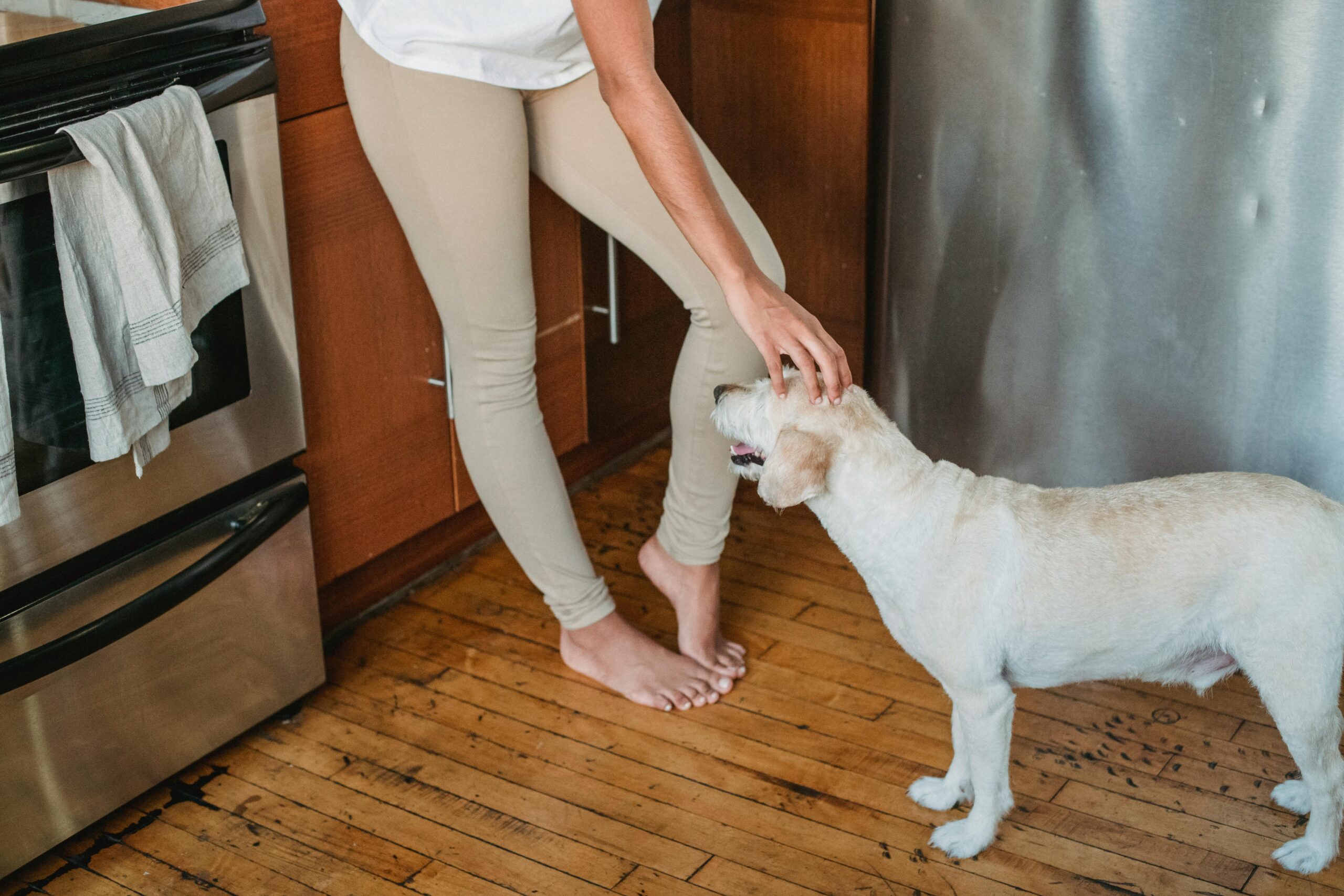Do you know what your dog is trying to tell you when he looks at you? How well do you understand a dog’s body language? Like humans, dogs use verbal and non-verbal language to communicate emotional state and intentions.
While dogs will bark their message, most of their information comes from body language. This process will not only strengthen your bond, but it will help you with dog training and working together.. Let’s look deeper to understand what your dog is trying to tell you.
How Do Dogs Communicate With Their Pet Parents?
Each part of your dog’s body sends a message. Here is a quick summary of your dog’s body parts and its signals.
Tail: Wagging shows happiness and anticipation, while a stiff tail shows fear or aggression.
Ears: Erect ears signal alertness, while flat ears signal fear or submission.
Eyes: Wide-open eyes show your dog is friendly and alert, while narrowed eyes show he feels discomfort and possibly aggression.
Mouth: If your dog’s mouth is open with relaxed lips, your canine is in a friendly and relaxed mood. On the flip side, a closed mouth indicates stress and aggression.
Body posture: A relaxed body posture shows comfort and friendliness. Yet, when your dog shows a stiff and tense posture, he is fearful and might show aggression.

Understanding Common Dog Stances
Dogs use different postures to send different messages. Let’s look at some of the most common messages and reveal their meaning.
Relaxed and Approachable
When your dog is in this stance, he feels comfortable in the environment/situation. He allows people, children, and other animals to approach him.
How to notice: Dog is in a loose stance, has his ears up, head high, and tail tail down and relaxed. The dog’s mouth is open with its tongue out.
Dominant and Aggressive
Dogs try to assert dominance in their environment and alert other animals/people that they will act aggressively when challenged. Noting the difference between a dominant dog and a submissive dog is key to friendly and sociable encounters.
How to notice: The dog is in a stiff-legged stance, with his ears forward in a wide V shape and mouth open and C-shaped. His lips are curled with visible teeth/hackles raised. The dog’s tail is stiff and might vibrate from side to side.
Alert and Checking
This stance is common in hunting dogs, working dogs, herding dogs, and most terriers. When your dog detects something of interest or unknown, he will show the environment that he is paying attention. At the same time, your canine is assessing the situation.
How to notice: Dog is slightly leaned forward, standing on its toes, with his eyes wide open and tail horizontal, but not stiff. His eyes are wide open and mouth fully closed. The dog’s tail may slightly move from side to side.
Fearful and Aggressive
This is a sign of a frightened dog, but not a sign of submission. If pressed too hard, he might attack and show aggression. Dogs show this stance when they face the threatening individual directly.
How to notice: The dog has lowered his body, tucked his tail, and raised hair that runs down his spine. Ears are positioned back, while the lips are lips slightly curled with slightly visible teeth. / tucked tail / lowered body.
Fearful and Worried
In this case, we have a fearful dog, but he is more submissive. The difference is the dog tries to bring peace to a conflicting situation. By showing submission, the canine acknowledges the individual of higher status and tries to avoid contact.
How to notice: The body is lowered, with the tail down and may wag slightly. There is brief and indirect eye contact, and the dog might lick the face of the dominant animal.
Stressed and Distressed
This dog feels the environmental and social stress on his body. This stance, unlike most on the list, is not directed at another individual. Instead, the stance broadcasts the dog’s stressed state of mind to everyone around.
How to notice: The dog’s body is lowered with the tail down, and shows signs of rapid painting. You can also notice his ears are back and his pupils are dilated.
Extreme Fear
This is a stance of total submission. The dog is fearful and has completely surrendered to the higher status around him. The dog has accepted his lower status and shows submissiveness to prevent conflict or physical confrontation.
How to notice: The dog rolls onto its back and exposes the stomach. Turns his head to avoid direct eye contact and has his tail tucked. Eyes are partly closed, with the ears flat and back.
Playful Puppy
Hopefully, your dog is in this stance most of the time. This is the basic invitation to play, either with other animals or people. Sometimes, dogs will follow up this stance with playful barking.
They use this posture several times during play to show that any previous behavior was not a threat or a challenge. They will hold the stance for a few seconds, before initiating play or running in a random direction.
See also

How to notice: The dog has lowered his front end with bent forepaws. His mouth is open with exposed tongue and tail up and broadly waving.
Your Dog’s Methods of Communication
Paying attention to your pet’s body language can prevent incidents. Your dog will always try to communicate his intentions before acting upon them. For example, no dog will attack or bite before showing some signs.

Wagging Tails
For dogs, a wagging tail signals a readiness to interact and isn’t always a sign of friendliness. Yet, you cannot tell whether that interaction is aggressive or friendly. To determine what your dog is “saying”, you have to look at the rest of his body. Here are different tail wags:
- Slight wag – swinging the tail with small breadth, usually during greetings, saying “Hello”.
- Broad wag – friendly and sociable, it is the closest thing to the popular concept of the happiness wag. Dogs will drag their hips while wagging.
- Slow wag –tail lowered halfway, it signals a reduced level of social engagement. Slow wags fall in the middle, they are neither dominant (high) nor submissive (low) positions of the tail.
- Dominant wag – when the tail moves from a neutral position to a vertical one, arching over the back. Dogs put their tail high to release more scent from their anal glands, showing their arrival and marking their territory.
- Submissive wag – when the tail moves from a neutral position to a lower one, showing submissiveness. When the dog tucks the tail between the rear legs, he shows fearfulness and asks not to be harmed by the threat.
- Tiny, high-speed movements signal your dog is about to do something, usually, run or fight.
How do Dogs Without Tails Communicate?
Tailless dogs can communicate, but, with some limitations. They approach other animals and people cautiously to avoid miscommunication. Because of their limits, they use ear position, stance, and facial expression to signal their intent.
Difference Between a Smile and a Snarl
Like humans, dogs smile when they experience pleasing and soothing behavior. It is normal for canines to bare their teeth when they smile. The challenge is to make the difference between a smile and a snarl.
When a dog smiles, his lips are pulled back toward the rear of the jaw. Now let’s take a look at a snarl. The dog’s lips are lifted vertically and the nose becomes wrinkled. A snarl is often accompanied by a stiff facial expression and body posture.
Whale Eyes
To avoid accidents and bites, paying attention to whale eyes is your top priority. If you’re unfamiliar, whale eyes are when the whites of the eyes are visible, and the dog will avert his head slightly. His eyes remain fixated on something/someone, like he is looking for approval/help from his owner.
Dogs show whale eyes when they feel anxious or uncomfortable. For example, other dogs approaching, or children trying to pet your dog.
When your dog shows off whale eyes, he wants you to pick up on the message and do something. You can stop whatever is causing your dog’s anxiety. For example, if another dog approaches, change direction and lead away. If children try to pet your anxious dog, kindly tell them to stop. Or offer them dog treats and have them feed your pet.
Always Look at Posture
A dog’s posture will tell you everything you need to know about their mood and intention. Always look at your dog’s complete body language, not only the tail.
Understanding body language ensures the well-being and safety of you and your pet. By paying attention to subtle cues like posture, facial expressions, and movements, we can respond before the situation gets out of control.


